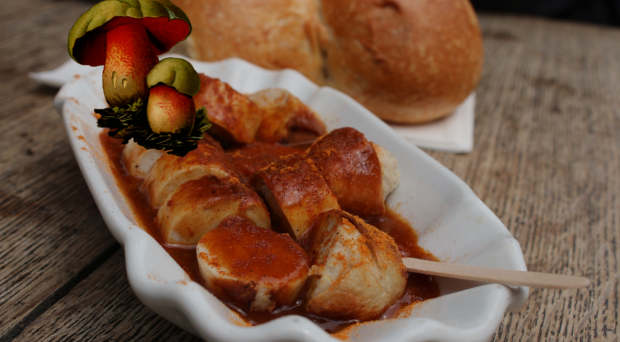
The Berlin currywurst, as everyone knows, is a part of the Berlin culture and for several decades has ranked besides the classic Döner as the most popular fast food meal in Germany. The recipe for success is quite simple, literally: A grilled sausage with or without skin, two ends, and lots of red sauce. The sauce doesn’t even have to taste like curry, but can just have curry powder sprinkled on top. There are many different versions of it and almost every takeaway in Berlin has its own variant.
Why am I writing about currywurst? I’m a vegetarian myself and don’t eat it, but I picked the topic today because the currywurst has been the focus of various media statements in recent times. So, here’s a little background story:
Why currywurst was about to be banished
The world’s largest automotive company, Volkswagen (VW), recently announced it was doing away with its famous canteen currywurst and would only offer meatless alternatives in the future. What a shock! One person did not like this announcement at all, the former chancellor Gerhard Schröder, who calls currywurst the power bar of the skilled workers (“Kraftriegel der Facharbeiter”) and promotes the famous meat product on social networks.
Many companies are moving toward meatless food, but this news has made big waves. VW’s currywurst is even so famous that it has its own Wikipedia article. In 2019, VW, with seven million servings, delivered more Currywurst to its canteen visitors than cars in the same period.
But it could be so simple with currywurst
Since I became a vegetarian 14 years ago, I’ve gotten to know many meatless alternatives to meat products. These products are usually based on tofu, soybeans or pea proteins mixed with or without eggs, and a lot of other additives for taste, form and seasoning.
And as a mushroom enthusiast, I’ve also noticed in recent years an increase in business efforts to use mushroom mycelium for meat substitutes.
Fungi for the sausage
So at this point I ask: Why don’t we talk about producing a sustainable mushroom-based currywurst, full of proteins and vitamins? It shouldn’t fail because of patent issues, at least, because it’s not clear who really invented the currywurst, but that’s the subject for another debate.
And since there are different guidelines for how to make currywurst, there should be no problems with making a currywurst with a “meatless” sausage. For example, the Bundesverband der Deutschen Fleischwarenindustrie e.V says:
“Fried or boiled sausage that is offered, usually sliced, with ketchup and curry powder and with a roll or french fries as a side dish. The Berlin currywurst is available with and also without skin.”
I claim that anyone who can make burger patties and bacon from mushrooms should also be able to make a currywurst. As a precaution, I also provide a modified definition for such a fungi currywurst:
“Fried or boiled vegan sausage, which was produced from fermented mushroom mycelium, pressed mushroom powder or reshaped fruit bodies. Usually sliced, with ketchup and curry powder and served with a bun or fries on the side.”
Maybe the currywurst can be reinvented in Berlin? Who knows for sure. Perhaps that would put an end to this long debate about the abolishment of the VW currywurst, and maybe the currywurst advocates will also be convinced by the mushroom sausage and understand that every meat alternative is an important step towards carbon neutrality.
Kustrim Cerimi
Latest posts by Kustrim Cerimi (see all)
- Connecting materials science with fungal biology: A personal insight - 15th June 2022
- Fungal pigments from the perspective of a scientist with passion for tattoos - 25th April 2022
- Fungal metabolites in pre- and postnatal human nutrition: How they may affect us and what to do about it - 25th March 2022
Comments